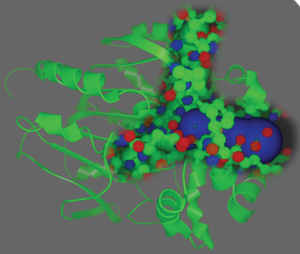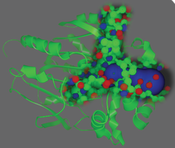Information
- Publication Type: Master Thesis
- Workgroup(s)/Project(s):
- Date: October 2018
- Date (Start): January 2018
- Date (End): 3. November 2018
- TU Wien Library:
- Open Access: yes
- First Supervisor:
- Pages: 100
- Keywords: molecular dynamics simulation, realtime visualization
Abstract
The aim of this thesis is a novel real-time visualization approach for exploring molecular dynamics (MD-)simulations. Through the constantly improving hardware and everincreasing computing power, MD-simulations are more easily available. Additionally, they consist of hundreds, thousands or even millions of individual simulation frames and are getting more and more detailed. The calculation of such simulations is no longer limited by algorithms or hardware, nevertheless it is still not possible to efficiently explore this huge amount of simulation data, as animated 3D visualization, with ordinary and well established visualization tools. Using current software tools, the exploration of such long simulations takes too much time and due to the complexity of large molecular scenes, the visualizations highly suffer from visual clutter. It is therefore very likely that the user will miss important events.
Therefore, we designed a focus & context approach for MD-simulations that guides the
user to the most relevant temporal and spatial events, and it is no longer necessary to explore the simulation in a linear fashion. Our contribution can be divided into the following four topics:
1. Spatial importance through different levels of detail. Depending on the type of
research task, different geometrical representations can be selected for both, focusand context elements.
2. Importance driven visibility management through ghosting, to prevent context
elements from occluding focus elements.
3. Temporal importance through adaptive fast-forward. The playback speed of the
simulation is thereby dependent on a single or a combination of multiple importance
functions.
4. Visual declutter of accumulated frames through motion blur, which additionally
illustrates the playback speed-up.
Since the very beginning, this work was developed in close cooperation with biochemists from the Loschmidt Laboratories in Brno, Czech Republic. Together, we analyzed different use cases demonstrating the flexibility of our novel focus & context approach.
Additional Files and Images
Additional images and videos
Additional files
Weblinks
BibTeX
@mastersthesis{trautner-2018-imd,
title = "Importance-Driven Exploration of Molecular Dynamics
Simulations",
author = "Thomas Trautner",
year = "2018",
abstract = "The aim of this thesis is a novel real-time visualization
approach for exploring molecular dynamics (MD-)simulations.
Through the constantly improving hardware and everincreasing
computing power, MD-simulations are more easily available.
Additionally, they consist of hundreds, thousands or even
millions of individual simulation frames and are getting
more and more detailed. The calculation of such simulations
is no longer limited by algorithms or hardware, nevertheless
it is still not possible to efficiently explore this huge
amount of simulation data, as animated 3D visualization,
with ordinary and well established visualization tools.
Using current software tools, the exploration of such long
simulations takes too much time and due to the complexity of
large molecular scenes, the visualizations highly suffer
from visual clutter. It is therefore very likely that the
user will miss important events. Therefore, we designed a
focus & context approach for MD-simulations that guides the
user to the most relevant temporal and spatial events, and
it is no longer necessary to explore the simulation in a
linear fashion. Our contribution can be divided into the
following four topics: 1. Spatial importance through
different levels of detail. Depending on the type of
research task, different geometrical representations can be
selected for both, focusand context elements. 2. Importance
driven visibility management through ghosting, to prevent
context elements from occluding focus elements. 3. Temporal
importance through adaptive fast-forward. The playback speed
of the simulation is thereby dependent on a single or a
combination of multiple importance functions. 4. Visual
declutter of accumulated frames through motion blur, which
additionally illustrates the playback speed-up. Since the
very beginning, this work was developed in close cooperation
with biochemists from the Loschmidt Laboratories in Brno,
Czech Republic. Together, we analyzed different use cases
demonstrating the flexibility of our novel focus & context
approach. ",
month = oct,
pages = "100",
address = "Favoritenstrasse 9-11/E193-02, A-1040 Vienna, Austria",
school = "Institute of Computer Graphics and Algorithms, Vienna
University of Technology ",
keywords = "molecular dynamics simulation, realtime visualization",
URL = "https://www.cg.tuwien.ac.at/research/publications/2018/trautner-2018-imd/",
}

 image
image Poster
Poster


